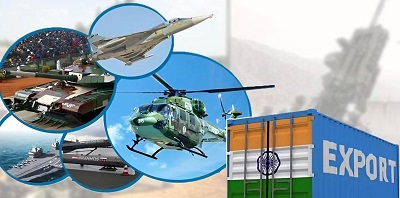Context-
Defence exports, involving the transfer of lethal weaponry and warlike equipment between countries under agreed terms, serve as an adjunct to a government's foreign policy and a key exercise of national prerogative. The success of this policy hinges on the nation's defence technology and the competence of its defence industry, which are intrinsically interrelated. India's defence export policy over the past decade, focusing on war-dedicated items within the broader defence inventory, particularly through the perspective of the nation's military forces.
Significance of Defence Exports
Nations with competent defence industries engage in defence exports for various statecraft objectives, including political goals, military alliances, and profitable trade. These exports are regulated by domestic and collaborative production needs and the requirements of politically friendly entities, both state and non-state. Motivations for defence exports include:
- Forging Political and Military Partnerships: Examples include the US, EU, Russia, and the UK, who export to strengthen alliances.
- Capturing Political and Military Dependencies: Countries like China, Russia, Türkiye, and Iran use exports to spread strategic influence.
- Commercial Enterprise: Nations such as France, Sweden, and Italy export to fund defence research, technology upgrades, and employment.
However, defence exports can have unintended consequences. For instance, American weapons turned against allied Republicans during the Chinese Civil War, and the Western Powers' weaponization of West Asian outlaws exemplify such pitfalls.
India's Defence Export Journey
Post-Independence Era
At the time of independence, India’s defence industry was modest, primarily meeting its post-independence needs and fulfilling security obligations towards Nepal and Bhutan. India also transferred limited weaponry and equipment to neighboring countries like Myanmar, Sri Lanka, Maldives, and Afghanistan as part of broader defence diplomacy rather than commercial exports.
India’s early national security policy emphasized ‘peace and friendliness,’ leading to a systemic disorientation regarding the role of military power in nation-building. This resulted in the stymieing of defence industry development, leading to outdated military inventory and a state-owned defence sector with little user demand, industrial collaboration, or global trade competition.
Post-1962 and 1965 Wars
Despite some improvements after the Sino-Indian War (1962) and the Indo-Pakistan War (1965), India’s defence industry remained largely stagnant, constrained by fiscal limitations and a ‘no defence exports’ policy. This prevented the modernization of the industry and hindered the development of export demands, trapping the nation in a self-imposed debility.
Shift Towards Pragmatism
The situation began to change post-1990, especially after the 2014 government recognized the harsh realities of regional belligerence. The role of geopolitics in arms trade was appreciated, leading to a boost in defence production and an opening up of defence export policies to strengthen international diplomacy and generate funds for defence modernization.
The global defence export market reached USD 750 billion in 2022, projected to grow to USD 1.38 trillion by 2030, with major exporters including the US, Russia, France, China, and Germany.
Recent Policy Articulations
India’s journey towards a robust defence export policy involves several key initiatives:
- Innovation for Defence Excellence (IDEX): Promotes innovation in defence technology.
- Defence Exports Steering Committee: Coordinates and promotes defence exports.
- Positive Indigenisation List: A list of 411 major military hardware items, aimed at reducing import dependency.
The government's Defence Production & Export Promotion Policy (DPEPP) aims to enhance defence R&D and promote self-reliance, aligning with the 'Make In India' initiative.
Promises of Resurgence in Defence Exports
The recent policy measures are expected to yield significant gains:
- Technological and Industrial Uplift: Harnessing indigenous IT, MSME, and start-up regimes.
- Substitution of Defence Imports: Improving foreign trade balance and generating funds for military modernization.
- Strategic Interdependencies: Entering global defence manufacturing and supply chains, fostering military interoperability with strategic partners.
- Boosting Diplomatic Leverage: Enhancing influence in the Indo-Pacific Region.
The government aims for defence exports to reach Rs 35,000 crore by 2025 and Rs 50,000 crore by 2028-29.
Current Status of Defence Exports
India's defence exports now reach over 75 countries, including Italy, Russia, Maldives, Mauritius, Seychelles, Sri Lanka, Australia, Japan, Israel, Brazil, UAE, Egypt, Indonesia, Thailand, the US, UK, France, and Armenia. Exported items include mid-technology ammunitions, missiles, rockets, torpedoes, artillery guns, drones, electronics, armoured vehicles, patrol boats, protective gear, radars, and surveillance systems.
India ranks among the top 25 global defence exporters, with exports surging from Rs 686 crores in 2013 to nearly Rs 16,000 crores in 2023, primarily driven by the private sector.
Looking Ahead
The new government must build on past achievements to further enhance defence exports. Key imperatives include:
- Simplifying Rules: For defence industrialization and trade.
- Collaboration and Funding: Boosting defence and academia sectors for research and innovation.
- Addressing Infrastructural Deficits: Preventing delays in mission-critical projects.
- Strategic Partnerships Model: Institutionalizing defence production and exports.
Conclusion
India stands on the brink of a new era, aiming for an annual defence production of Rs 3 lakh crore and boosting defence exports to Rs 50,000 crores. The primary achievement of post-2014 governments has been challenging past foreign policy reticence and charting new paths towards a sovereignty-empowered, self-reliant, and globally respected India.
A whole-of-government approach is essential to sustain this progress, integrating defence industrialization, technological advancements, and balanced management of imports and exports with a robust defence diplomacy.
|
Probable Questions for UPSC Mains Exam-
|
Source- VIF







